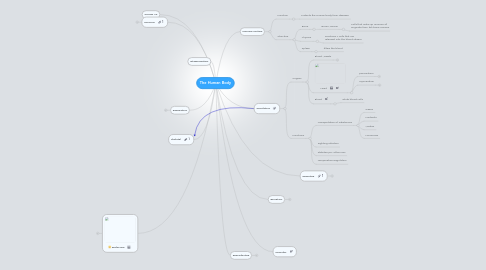
1. Carries Air
2. Skeletal
3. Respiratory
3.1. Organ
3.1.1. Pharynx
3.1.1.1. Moves air into the lungs
3.1.2. Trachea
3.1.2.1. Moistens and warms air as it goes into the lungs
3.1.2.2. Protects the respiratory surface from an accumulation of foreign particles
3.1.3. Larynx
3.1.3.1. Vocal Cords
3.1.3.1.1. Allows for speech
3.1.4. Lungs
3.1.4.1. Responsible for the exchange of gases (mainly O2 and CO2)
3.1.5. Nasal Passage
3.1.5.1. cleans air that eneters through the nose
3.1.5.2. Allow sound to resonate when you stimulate your vocal cords
3.2. Function
3.2.1. Supply blood with O2
3.2.1.1. to get the heart to deliver O2 to all of body
4. Endocrine
4.1. function
4.1.1. secretes a type of hormone directly into the bloodstream to regulate the body
4.1.2. have secondary endocrine functions
4.2. organs
4.2.1. is a system of glands
4.2.1.1. kidney
4.2.1.2. liver
4.2.1.3. hearts
4.2.1.4. gonads
5. Nervous
5.1. Function
5.1.1. Interneurons
5.1.1.1. Transfer and interpret impulses
5.1.2. Sensory Neurons
5.1.2.1. Receive Information from the sensory receptors
5.2. Organs
5.2.1. Central
5.2.1.1. Brain
5.2.1.2. Spinal Cord
5.2.2. Peripheral
5.2.2.1. sensory organs of smell
5.2.2.2. sensory organs of taste
5.2.2.3. Ears
5.2.2.4. Eyes
5.3. Motor Neurons
5.3.1. Send appropriate impulses/instructions to the muscles and glands
6. Integumentary
7. Muscular
8. Circulatory
8.1. Organs
8.1.1. Blood Vessels
8.1.1.1. Types
8.1.1.1.1. Veins
8.1.1.1.2. Capillaries
8.1.1.1.3. Arteries
8.1.2. Heart
8.1.2.1. pericardium
8.1.2.1.1. contains
8.1.2.2. myocardium
8.1.2.2.1. nervous tissue
8.1.2.2.2. muscle tissue
8.1.3. Blood
8.1.3.1. white blood cells
8.2. Functions
8.2.1. Transportation of substances
8.2.1.1. Gases
8.2.1.2. Nurtients
8.2.1.3. Wastes
8.2.1.4. Hormones
8.2.2. Fighting infection
8.2.3. Stabilize pH, other ions
8.2.4. Temperature Regulation
9. Excretory
9.1. Organs
9.1.1. skin
9.1.2. lungs
9.1.3. kidney
9.1.4. bladder
9.1.5. Ureter
9.1.6. Urethra
9.1.7. Nephron
9.1.7.1. hormones regulate amount of absorption
9.1.8. liver
9.1.9. urinary system
9.2. Function
9.2.1. helps maintain homeostasis
9.2.2. filters out unnecessary material
9.2.3. Responsible for elimination of waste products
9.2.4. Removes carbon dioxide, water, salt, water, urea and uric acid
10. Reproductive
10.1. Male
10.1.1. Organs
10.1.2. Functions
10.1.2.1. Creates sperm to fertilize female egg
10.2. Female
10.2.1. Organs
10.2.1.1. Ovary
10.2.1.1.1. Eggs
10.2.2. Functions
10.2.2.1. Creates egg to be fertilized by sperm, which then will grow into another human.
11. Digestive
11.1. Organs
11.1.1. Mouth
11.1.2. Throat
11.1.3. Esophagus
11.1.4. Stomach
11.1.5. Small Intestine
11.1.6. Large Intestine
11.2. Function
11.2.1. Turns food into energy
11.2.2. Creates waste to be eliminated
12. Immune System
12.1. Function
12.1.1. Protects the Human body from diseases
12.2. Structure
12.2.1. Bone
12.2.1.1. Bone Marrow
12.2.1.1.1. Cells that make up immune all originate from teh bone marrow
12.2.2. Thymus
12.2.2.1. Produces T cells that are released into the blood stream.
12.2.3. Spleen
12.2.3.1. filters the blood
